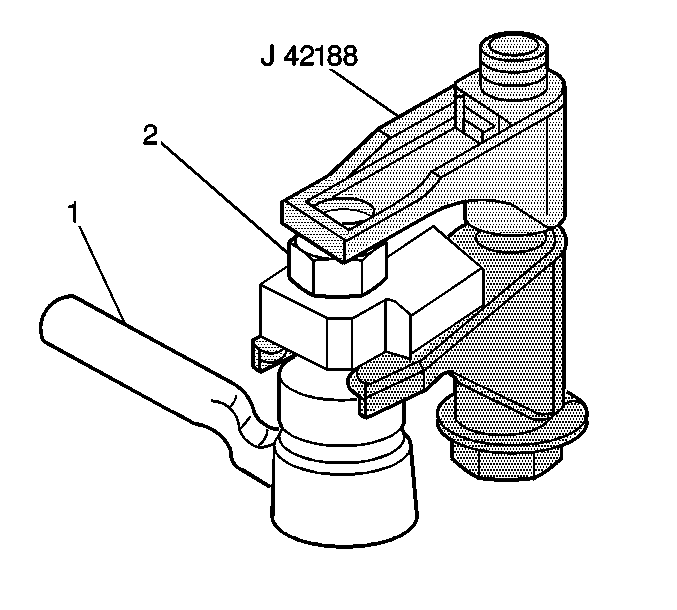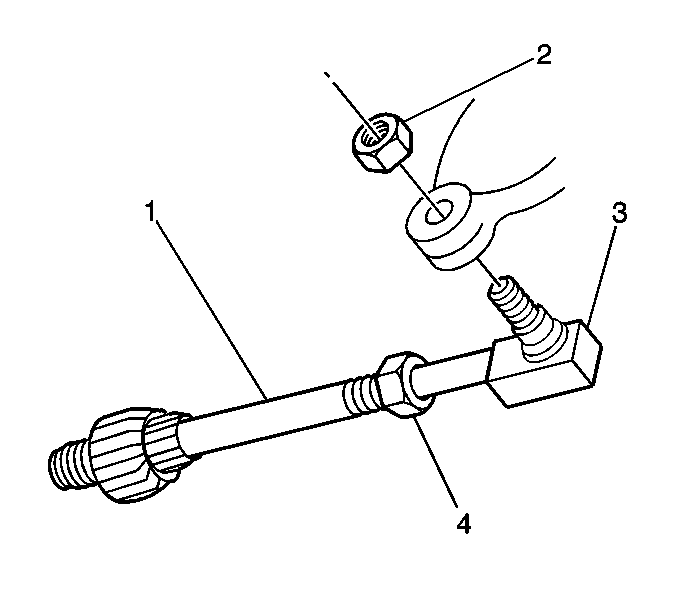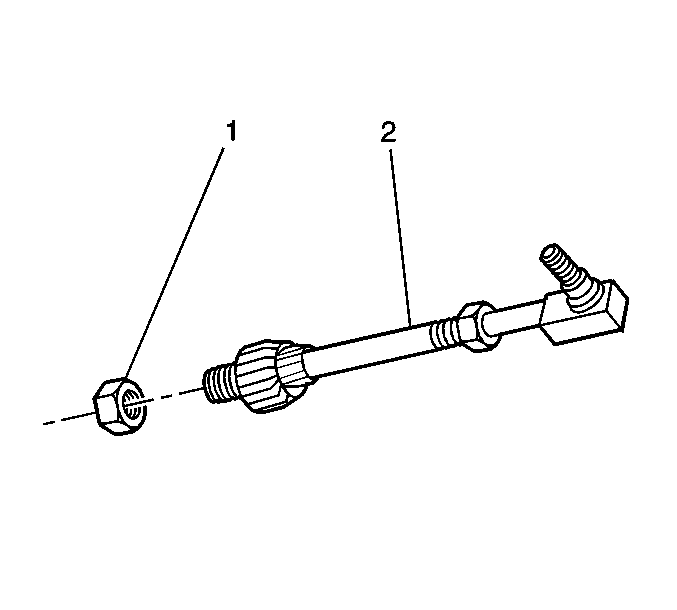Tie Rod Replacement Outer End
Tools Required
J 42188 Ball Joint Separator
Removal Procedure
- Raise and support the vehicle. Refer to Lifting and Jacking the Vehicle in General Information.
- Remove the tire and wheel assembly. Refer to Tire and Wheel Removal and Installation in Tires and Wheels.
- Loosen, do not remove, the outer tie rod end stud nut (2) from the outer tie rod end ball stud.
- Install J 42188 between the steering knuckle and the outer tie rod end stud.
- Tighten the bolt on J 42188 until the steering knuckle and the outer tie rod end stud separate.
- Remove J 42188 and the outer tie rod end stud nut.
- Remove the outer tie rod end stud from the suspension knuckle.
- Loosen the jam nut (4) on the rear suspension adjustment link.
- Remove the outer tie rod end (3) from the rear suspension adjustment link (1).


Installation Procedure
- Install the outer tie rod end (3) to the rear suspension adjustment link (1).
- Install the outer tie rod end into the suspension knuckle.
- Install the outer tie rod end nut (2).
- Install the tire and wheel assembly. Refer to Tire and Wheel Removal and Installation in Tires and Wheels.
- Lower the vehicle.
- Adjust the rear wheel toe as necessary and tighten the rear suspension adjustment link lock nut. Refer to Rear Toe Adjustment in Wheel Alignment.

Notice: Use the correct fastener in the correct location. Replacement fasteners must be the correct part number for that application. Fasteners requiring replacement or fasteners requiring the use of thread locking compound or sealant are identified in the service procedure. Do not use paints, lubricants, or corrosion inhibitors on fasteners or fastener joint surfaces unless specified. These coatings affect fastener torque and joint clamping force and may damage the fastener. Use the correct tightening sequence and specifications when installing fasteners in order to avoid damage to parts and systems.
Tighten
| • | Tighten the outer tie rod end nut (2) to 20 N·m (15 lb ft) to seat the outer tie rod stud. |
| • | Turn the nut an additional 160 degrees. |
| • | Check the outer tie rod end nut for a minimum torque of 45 N·m (33 lb ft). |
Tie Rod Replacement Suspension Link
Removal Procedure
- Raise and support the vehicle. Refer to Lifting and Jacking the Vehicle in General Information.
- Remove the tire and wheel assembly. Refer to Tire and Wheel Removal and Installation in Tires and Wheels.
- Disconnect the outer tie rod end from the suspension knuckle. Refer to Tie Rod Replacement .
- Remove the nut (1) retaining the rear suspension adjustment link to the crossmember.
- Remove the rear suspension adjustment link (2) from the vehicle.

Installation Procedure
- Install the rear suspension adjustment link (2) to the vehicle.
- Install the rear suspension adjustment link nut (1) to the back side of the crossmember.
- Install the outer tie rod end into the suspension knuckle. Refer to Tie Rod Replacement .
- Install the tire and wheel assembly. Refer to Tire and Wheel Removal and Installation in Tires and Wheels.
- Lower the vehicle.
- Adjust the rear wheel toe as necessary. Refer to Rear Toe Adjustment in Wheel Alignment.

Notice: Use the correct fastener in the correct location. Replacement fasteners must be the correct part number for that application. Fasteners requiring replacement or fasteners requiring the use of thread locking compound or sealant are identified in the service procedure. Do not use paints, lubricants, or corrosion inhibitors on fasteners or fastener joint surfaces unless specified. These coatings affect fastener torque and joint clamping force and may damage the fastener. Use the correct tightening sequence and specifications when installing fasteners in order to avoid damage to parts and systems.
Tighten
Tighten the rear suspension adjustment link nut to 60 N·m
(44 lb ft).
